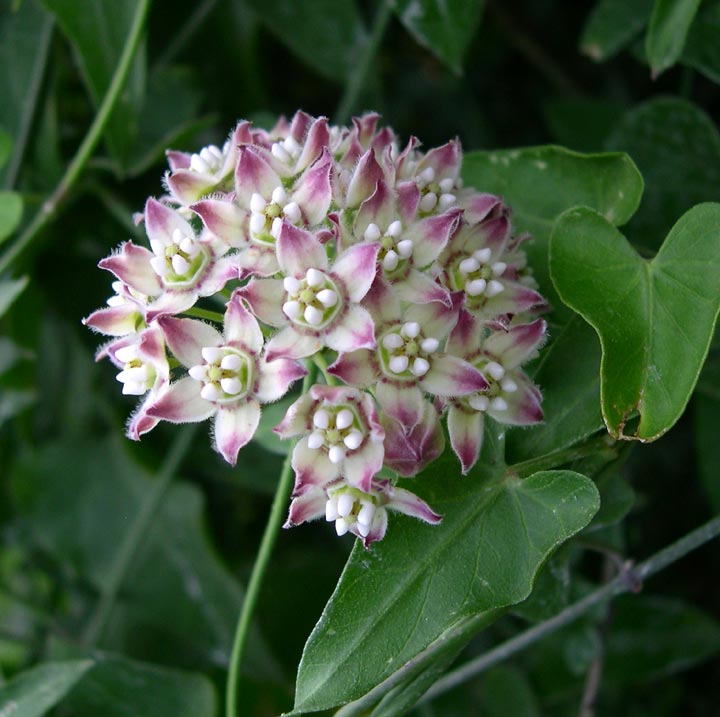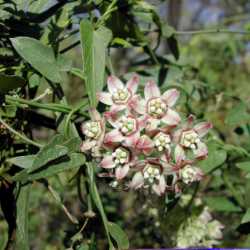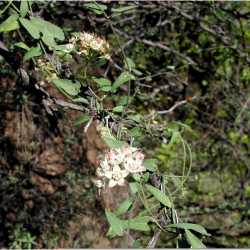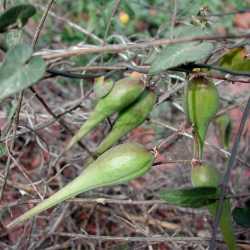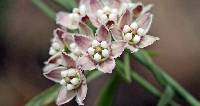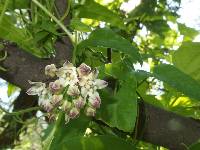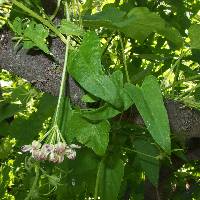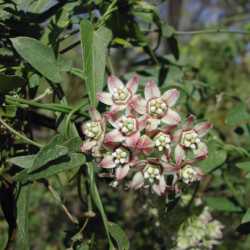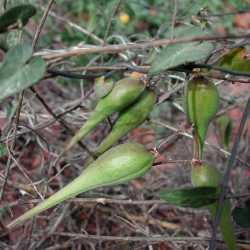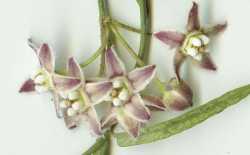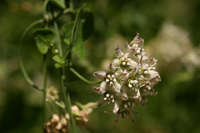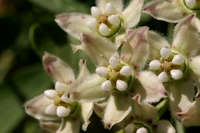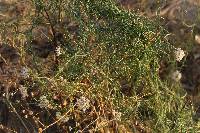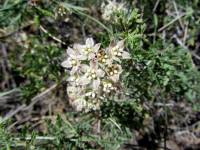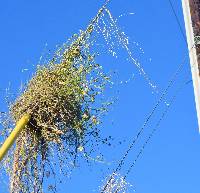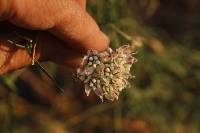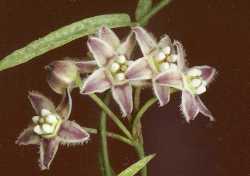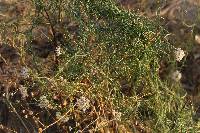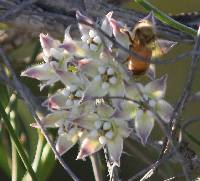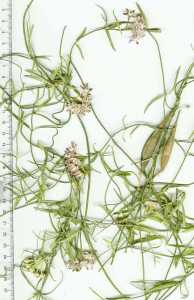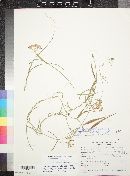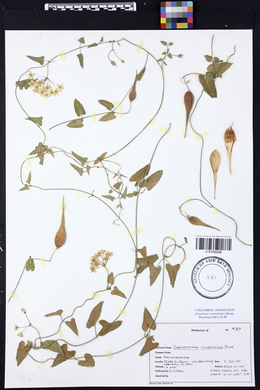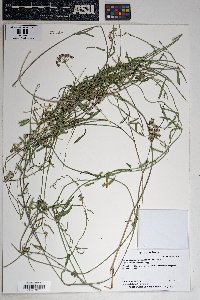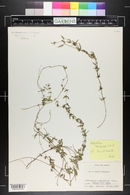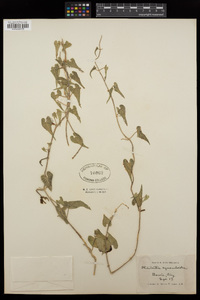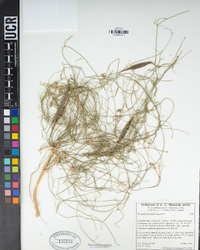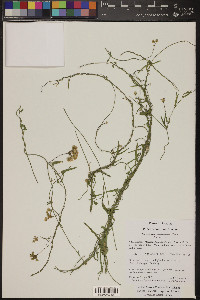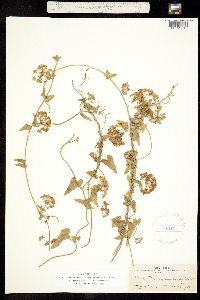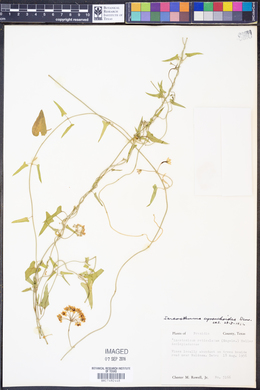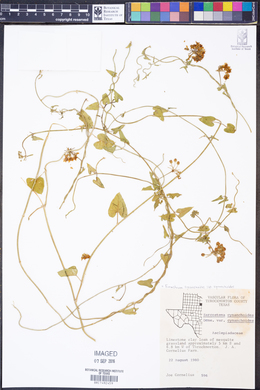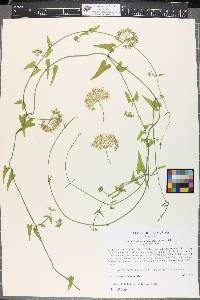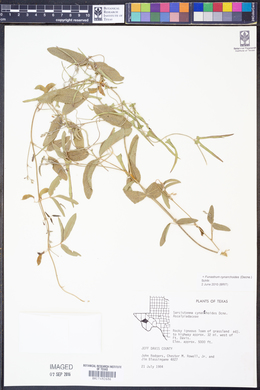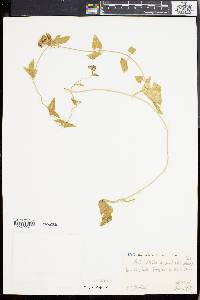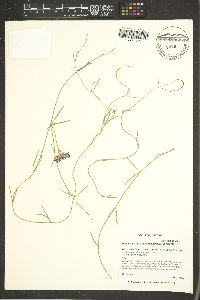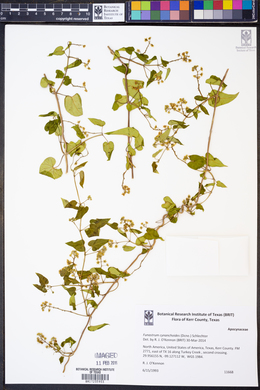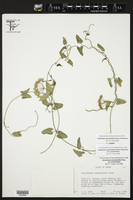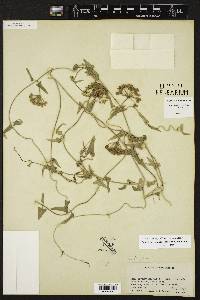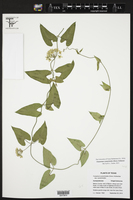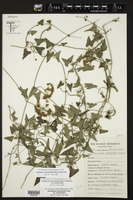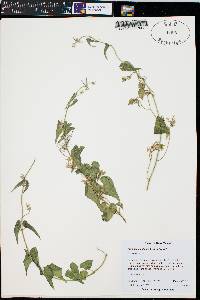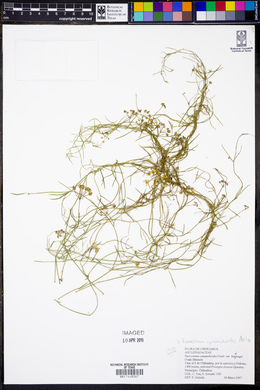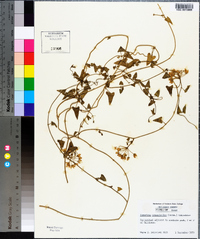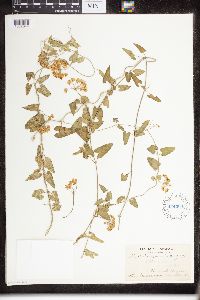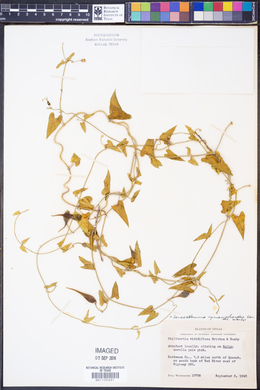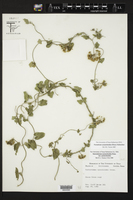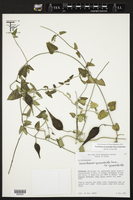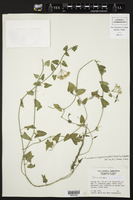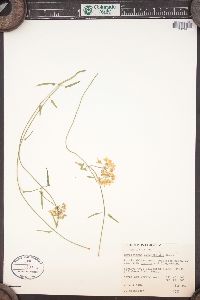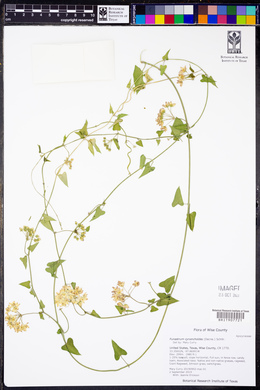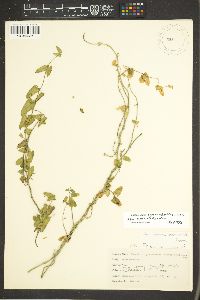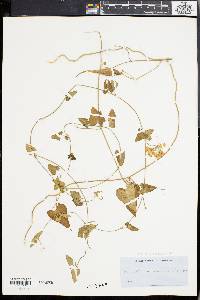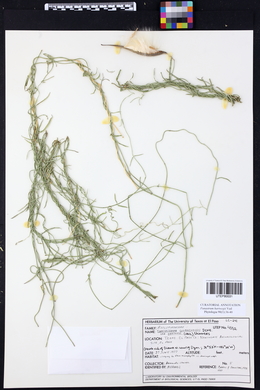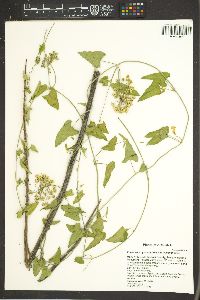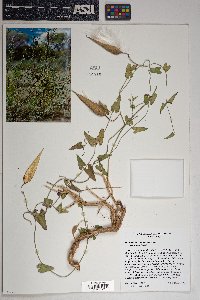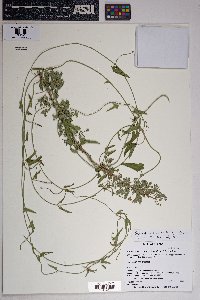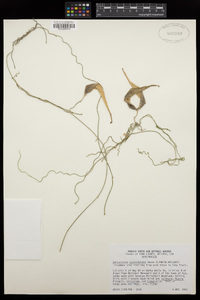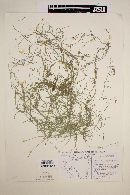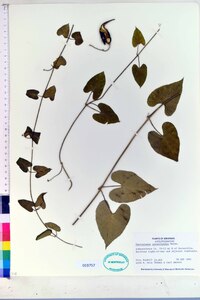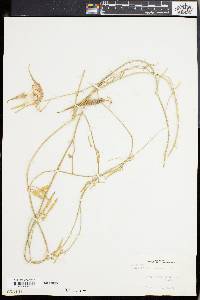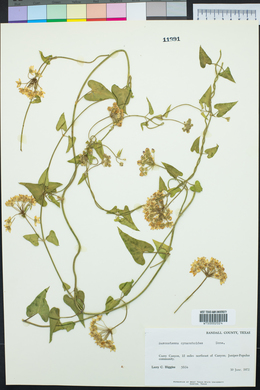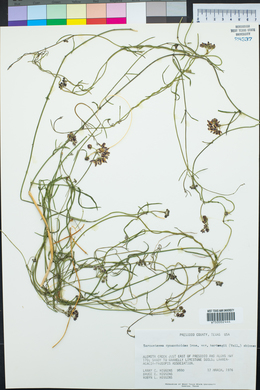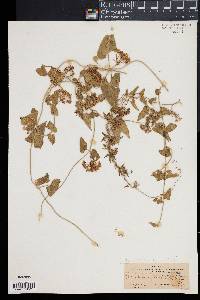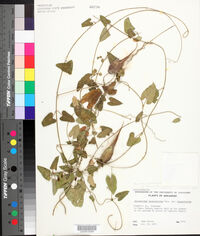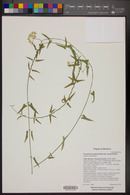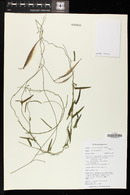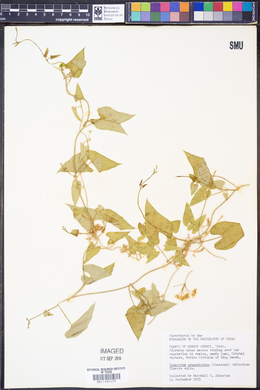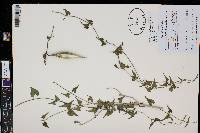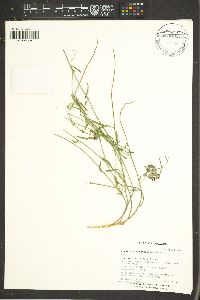
|
|
|
|
Family: Apocynaceae
climbing milkweed, more...fringed twinevine, Fringed Twinevine, fringed twinevine (es: guirote, huirote)
[Funastrum cynanchoides subsp. cynanchoides, moreFunastrum cynanchoides var. cynanchoides , Funastrum cynanchoides var. subtruncatum (B. L. Rob. & Fernald) J. F. Macbr., Philibertella cynanchoides (Decne.) Vail, Philibertia cynanchoides , Sarcostemma cynanchoides Decne., Sarcostemma cynanchoides subsp. cynanchoides , Sarcostemma cynanchoides var. cynanchoides , Sarcostemma texanum Engelm. ex Torr.] |
LEAVES: ovate to broadly lanceolate, to 3-4 times as long as broad, the bases cordate, the petioles mostly 1-4 cm long; flowers predominantly white; follicles mostly 6-8 cm long. NOTES: See also parent taxon for more description. Flood plains, canyons, disturbed sites, nc to se AZ: Cochise, Coconino, Graham, Pima, Pinal, Santa Cruz, Yavapai cos.; 750-1200 m (2400-4000 ft); Jul-Nov; NM, OK, TX; n Mex. REFERENCES: Sundell, Eric. 1994. Asclepiadaceae. J. Ariz. - Nev. Acad. Sci. Volume 27, 169-187. Plant: Perennial herbaceous vine; stems glabrate or sparsely pubescent at the nodes; milky sap Leaves: ovate to mostly lanceolate or linear, cordate to hastate, sagittate or truncate at the base, rarely obtuse, the margins flat, 1-8(-10) cm long, sparsely pubescent to glabrate on both surfaces, the petioles 0.2-4 cm long INFLORESCENCE: UMBELS 5-30 flowered, the peduncles mostly 1-6 cm long, the pedicels with spreading or curved hairs Flowers: 5-7 mm long; calyx pubescent to subpilose, the lobes ovate to ovate-elliptic, mostly 2-3 mm long, less than 3 times longer than broad; corolla rotate to broadly cup-shaped, bright purplish to white, pubescent outside, minutely so inside, the tube 1.5-2.5 mm long, the lobes ovate to ovate-triangular, 4-6 mm long; crown ring free from the base of the vesicles, 0.2-0.5 mm high, the vesicles arising from a short column less than 1 mm above its union with the corolla tube, ca. 1.5-2.5 mm long in the upper portion, longer than broad, rounded at the top and smoothly contoured on the tangential surface, indistinctly constricted at the base; column 0.5-1 mm high beneath the anther wings, these 1-1.2 mm long; corpusculum ca. 0.2 mm long, the pollinia 0.7-0.8 mm long Fruit: FOLLICLES single, lanceolate-attenuate, 6-12 cm long Misc: Desert washes and slopes, canyons, floodplains, disturbed sites Notes: pollen in sacks (pollinia); seeds with hairs attached References: E. Sundell. Asclepiadaceae. JANAS 27:169-187. J.C. Hickman, ed. The Jepson Manual.ASU specimens. Wiggins 1964, Sundell 1993, Kearny and Peebles 1979 Duration: Perennial Nativity: Native Lifeform: Forb/Herb General: Slender herbaceous stems to 2 m long from woody root and short caudex; herbage glabrous or nearly so; plants with milky sap. Leaves: Opposite and short-petiolate, the petioles to 4 cm; blades ovate, lanceolate or linear, 1-10 cm long; base of blades cordate, hastate, saggitate or truncate; margins flat; surfaces sparsely pubescent to glabrate. Flowers: White or purple, in many-flowered umbels, those on peduncles 2-5 cm long; pedicels 1-2 cm long, puberulent; flowers about 1 cm broad; calyx lobes ovate-elliptic, puberulent without; corolla rotate to broadly cup-shaped, bright purplish to white, pubescent outside, the lobes ovate-triangular, 4-6 mm long; crown ring free from the base of the vesicles, 0.2-0.5 mm high, the vesicles arising from a short column < 1 mm above its union with the corolla tube. Fruits: Follicles solitary, lanceolate-attenuate, 3-12 cm long, about 1.5 cm in diameter, finely striate. Ecology: Found sprawling over bushes, along desert washes, canyons, and disturbed sites from 500-5,500 ft (457-1372 m); flowers March-December. Distribution: CA, NV, AZ, NM, TX; south to c MEX. Notes: A twining perennial vine with milky sap, the leaves are a bit broader, less hairy, and margins less wavy compared to the similar F. crispum. Also, the calyx lobes are ovate as opposed to lanceolate in F. crispum. Some treatments and genetic analyses separate the two subspecies, hartwegii and cynanchioides into distinct species. However, this guide treats them as subspecies, sesnu Sundell-s treatment for Arizona. F. cyanchoides ssp. cyanchoides has heart-shaped leaves, predominantly white flowers, and a narrower elevation range, 2,400- 4,000 ft; while F. cyanchoides ssp. hartwegii (syn. F. heterophyllum) has leaves shaped like arrowheads, purple and white flowers, and a wider elevation range, 500-5,500 ft. Ethnobotany: Unknown for this species. Etymology: Funastrum is from funis, a rope, cord, or sheet and astrum, incomplete resemblance, while cynanchoides refers to being like the genus Cynanchum. Synonyms: Sarcostemma cynanchoides, Funastrum cynanchoides var. subtruncatum, others, see Tropicos Editor: SBuckley 2010, FSCoburn 2015, AHazelton 2015 |
|
|
|
This project was made possible in part by the Institute of Museum and Library Services [MG-70-19-0057-19].
Powered by Symbiota

